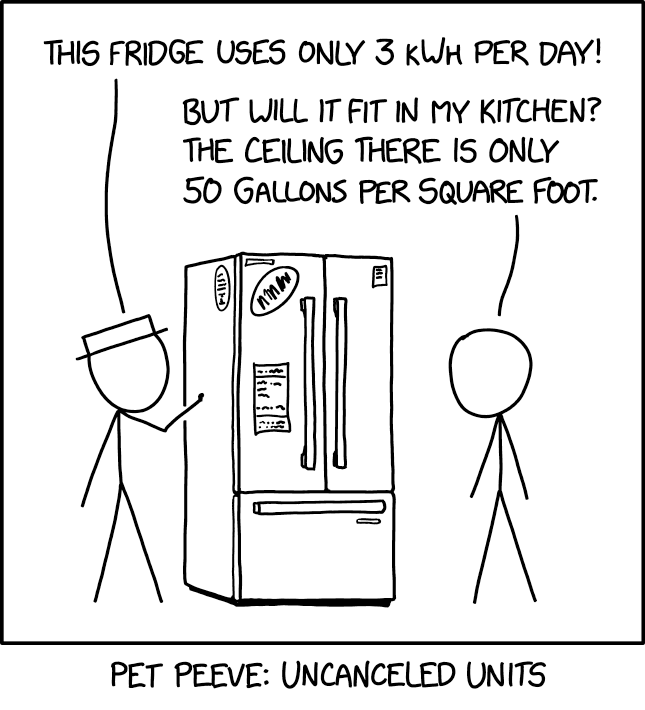Edit: Alt Text: Speed limit c arcminutes^2 per steradian.
Going from Watts to BTU’s while researching for a solid state multi-power-state TEC cooling solution. I feel this.
And they’re cursed for a region, you don’t define a distance as volume! As I’m typing that, I realise this also defines a distance as a bodypart, ah well
But what temperature is that at? And what is the ambient temperature? And what if the power is not at exactly 120V? And what about if I put a fresh dead hooker in it every day?
If we just used watts life would be so much easier.
The beauty of SI units is you just add or remove zeroes.
Unless you’re converting seconds to minutes, hours, days, years, etc.
Then you get things like watt hours. Or light years.
Which is why neither are SI-units
The Hives were right, we need to convert to the metric system for time.
Fun trivia. It’s called a second because it’s the second division of an hour after minutes. You can keep going with thirds and fourths for sub second time.
Ahh, daylight saving saves on Kwh!
For something that doesn’t run continuously, like eg. a refrigerator, then an average daily usage is more useful, no? “This product draws 1.5 kW with a duty cycle of 0.08” doesn’t really help when comparing efficiencies of potential purchases, you’d need to convert it to electricity consumed in a set period anyway.
No, it’s because watts are joules per second, so kWh are (energy / time) * time. Cancelling the units would be expressing the energy directly in joules.
But the XKCD mentions kWh/day specifically, in theory the times can cancel out, leaving you with kW
But instantaneous and average kW are very different, and it would take more time to describe that distinction than to use kWh/day.
My freezer was labeled in max watts, kwh/day, and kwh/year. Because the cumulative watts over time is what I pay for my power bill. That way it’s a simple multiplication that tells me how much having that freezer would cost.
Ok that’s fair, I kinda glossed over that part. Both are valid interpretations, I think.
Exactly, it’s a unit of convenience, not a unit of abstract precision.
Even a unit of “gallons/sqft” could be handy in the right context. If you were trying to design a storage solution for discretely packaged product for example, it could be a figure of merit despite literally factoring out to a unit of length.
Yeah a chest freezer is a good example of a situation where both are useful things to put on the tag
I could imagine a scenario where gal/ft² is useful. Like with grocery store shelving figuring shelving and product stacking. If liquid storage containers are stackable then you have have more gallons per square footage of shelf space. Or of they’re not stackable, then taller containers would hold more liquid in the same shelf space than shorter containers with the same footprint.
Yeah it seems odd to represent something as a volume/area, but that is the relevant information you’re comparing and it’s intuitive how that number changes based on changes to volume as projected onto an area. Bigger number points toward a more efficient use of shelving.
It’s pretty common to use acre inches and acre foot as a unit of volume for measuring water in agriculture, water use, flood mitigation, etc.
So if we can use area height as a volumetric unit, by not volume/area as a height unit?
US customary has gone too far and must be destroyed
I can’t imagine why kWh would be more convenient than MJ though.
Because people have an intuitive feeling about how much 1 kW is, because they use devices with a power rating in Watt and have a feel for how powerful a device is at what rating. People also know exactly what an hour is. So it makes sense to think about a device of 1kW running for 1 hour, people have a good sense of how much energy that is in daily use. Since most energy bills are also in terms of kWh, people also have a good sense about the costs of that energy.
Given the popularity of the unit, I think people like it, otherwise a different unit would have been used already.
Yeah i haven’t dealt with joules on a regular basis since college. They may as well be coulombs to my instinctive understanding
Right, so it’s only the popularity of the unit. If everyone would use MJ that’s what people would be used to and there’d be no real difference.
Because the power draw of appliances is measured in watts, so a 60 watt light bulb when lit draws 60 watts of power over the course of one hour. So if I have roughly 100 lightbulbs at 60 watts hooked up to my house, then I’ll be using 6 kW of power each hour.
It tells us more information about the rate of use of that energy. It’s like the difference between a 2 lb sphere of uranium being exploded in a fraction of a second vs 2 lb lf uranium fuel in a reactor operating for however long that much fuel lasts for. Both contain the same amount of joules of energy at the end of the process, one just uses all of those joules in one go and the other slowly releases that energy over a longer period of time.
kWh is just a measure of energy though. B it says nothing about the time in which it’s expended. It’s possible to use a kWh in a minute.
Glad to see reading comprehension is at an all time high and I definitely didn’t explain how total joules doesn’t actually mean anything for something drawing power in relation to the time its drawing power. And I didn’t make any comparison about how a 2lb lump of uranium contains the same energy whether it’s detonated in a bomb or slowly released in a reactor.
My point is that kWh is the same. It doesn’t say anything about time. 1 kWh is 3.6 MJ. There is no difference except the factor 3.6.
The important thing is that leaving units uncanceled is a valid way to communicate the relevant factors of what a number represents.
Yes technically kWh cancels down to joules, but that doesn’t communicate the relevant info of how a device uses that energy during a period of time. In other words Work (Watts) multiplied by Time (hours).
Uranium has 2x10¹³ joules of energy stored. You can use all that energy at once in a bomb and explode a city in a second, a lot of Work done very quickly, ooooor you could put it into a reactor and power a city and do a lot of Work during a much longer time period.
You could also list some long term average power draw instead of the peak.
kWh is already an uncanceled unit, drives me nuts even without adding per day
(Energy / time) * time? fuck you
It’s because the times aren’t the same. Maybe same unit but different context so they can’t be canceled.
It’s like saying you work 8 Hours/day (Eight hours per day). Both are units of time, but their context is different and their combination forms a new meaning beyond the units.
1 KWh is using 1KW for one hour. Because of demand pricing the time you use that KW is important. Like in terms of energy grid using a whole ton of power for one minute vs same total over a long time is different and important dispite being the same amount of energy.
Edit: some phrasing
Time cancels out.
I work 8.
Rough day today, I pulled 10 radians.
Gotta convert time to the same units before canceling: you work 1/3
Good point, and agreed that thinking in kWh is very intuitive and convenient in some contexts like household appliances, but it’s being used as a more general unit for energy while Joules are just so much better at, well, representing energy and being able to transition from electric to thermal etc.
I know why but it’s stupid and arbitrary and the arbitraryness is what’s forcing it.
It’s the time. It’s always the time.
SI units are all derived from seconds but instead of working with kiloseconds we have minutes and hours and days with a bunch of idiotic conversions.
The “second” you invite time into your measure, you invite some real bullshit ad-hoc pseudo-unit convenience units and fuck them. May as well just go imperial and have 14 rods to the fucking hogshead.
Is that a standard hog or a chefs hog?
Because nobody’s used to seeing Joules, you could swap in kJ for kW-seconds but then you probably need to switch base (MJh) to keep it practical, and now people need to do extra math to tell what will be on their power bill
But go ahead and call your power company to get them to list Joules
My power company provides me electricity in kWh, and heating (in the form of hot water) in GJ. And my cold water gets charged in m3.
So they DO know. For a few years, they’d even “helpfully” translate the GJ into kWh, untill it started to piss off people who bought electric heaters and found that those two numbers weren’t actually the same in the real world.
My power company DOES tell me in Joules, but only for gas so that’s already bullshit, and I live in Alberta so people already can’t decipher their fucking power bill’s opaque energy/distribution fee/transmission fee costs so that’s bullshit too
In the U.S., they meter gas by the “therm,” which is defined as 100,000 BTUs. It’s a misconception that it’s equal to 100 cubic feet of natural gas at standard temperature and pressure, and is merely a coincidence that those values are very close.
BTUs are like a shitty imperial calorie, the energy it takes to heat up one pound of water by one degree fahrenheit.
Also, don’t confuse therms for thermies, a totally different unit that means the amount of energy required to heat up a tonne (1000 kg) (not to be confused with the imperial ton that is 2000 pounds) of water by 1°C.
Energy is so useful in so many different contexts that we can just always expect a million ways to express it.
But …we’re human - bullshit is really all we’ve got.
I suppose there is science, but eww…
It’s also due to social inertia.
Power companies charge by the kWh because their generators are measured in total output wattage and consumers consume at different wattages at different times.
Sure, it would be easier to measure in total joules consumed per period time but it would also be easier to measure with world standard metric units. The pain of changing is harder than staying the same, so muh freedum units.
It gets even better when you read about annual or even daily energy production of a specific power plant.
For example, the annual production of Aswan dam in Egypt is about 10 042 GWh, which translates to an average power output of about 1.1 GW. Now that you have this number, you can compare that with the maximum theoretical power output which is 2.1 GW. Therefore, they should have plenty of capacity left, but you can’t tell that just by looking at the published numbers. They just have to use convoluted units, because that’s the tradition in a bunch of industries.
There’s nothing wrong with kilowatts, it’s an SI unit. The problem is hour, which is 3600 seconds, and we have ancient Egyptians to blame for this, who divided the day into 24 hours despite having already developed base-10 numerical system.
Kilowatt per kilosecond, which is 1 megajoule, would work better.
I really don’t get the issue with kWh. Things are rated in W and we mostly care about the hours they’re powered on. If I wanna figure out how many kWh a PC that needs 300W used in 4 hours, I multiply 300*4. If I wanna know how many joules it used, I have to do 300*4*3600. Only one of those can be done in your head in 3 seconds.
You gotta use an escape character, specifically a backslash ( \ ), when dealing with *s on lemmy.
Otherwise you end up with “stufflike this!”
When it could have been “stuff*like this*!”
ETA: Damn, you’re good. Fixed it before I even finished this post!
One pet peeve of mine is the usage of watts and kilowatts though. Chargers are often labelled like 1 second lasting batteries :/
Damn, I was convinced it was the Babylonians with their base-60 system.
That actually works great.
60 is cleanly divisible by 1, 2, 3, 4, 5, and 6, 10, 12, 15, 20, and 30.
10 is cleanly divisible by 1, 2, and 5.
I have no problem remembering what 1 is divisible by.
Yeah Babylon was very clever but also looking at their math and writing makes it clear why they had to have a class of people to do their math and writing
It would’ve been better if we had a 6 or 12 based number system
The big reason for 60 over 12 or 6 is the divisibility by 5. That makes it divisible by all numbers through the first 3 primes.
To get it divisible by all the numbers up to the next prime (7), you’d have to go to 420, and the one after that (11) you’d need to go to 27,720, and 13 would require a whopping 360,360.
The problem with base 60 is needing to know and remember instinctively the names, symbols, and relative positioning for 60 digits. Like, I love Babylon, they’re underrated for certain, but imagine teaching this to a 5 year old. Imagine doing calculus with this shit. Now remember that their writing impliment was a triangular reed and their written marks were entirely triangles and straight lines.
I knew a 26-letter alphabet by the time I was 2.
Yes, but set to music i assume and not nearly to the level one was expected to understand the ordering of digits.
In base 34: 1…9,a…z,10 it’s slightly more than half the digits the babylonians had, and as someone whose career involves a lot of math I don’t want to be dealing with at a glance trying to figure out the approximate difference between jl5x and ik8r
As an adult with a college degree in stem I know my digits and their ordering perfectly and without question unless literally trying to trip me up. The alphabet, I know in that specific order and would have to think to start in the middle. I don’t want to do series or sequences on that shit and if you do then good for you
That’s 203.7cm for anyone wondering
Assuming US Gallons. With Imperial Gallons, it’s 2.447 m
Damn, would’ve been an added joke to make the ceiling 150 gallons / ft2
My car needs 0.07 square millimeters of fuel on the highway.
square? Damn it uses no volume of fuel at all!
Isn’t that crazy efficient? I seem to remember about 0.3mm²?
Way back of you asked Google “38 mpg in mm^-2” it would tell you.
I love that it’s the size of the thread of fuel you would consume as you drive down the road.
Edit: oh no, that’s about right. It’s a diameter of about 0.25 mm. I think that’s what I was thinking of.
Not sure. I asked my cat Jeepity.
I need the alt text!
Sorry! I added it now.
First of all, thanks for posting new threads here, it was getting somewhat dull that I was in recent weeks always the first one, sometimes after several days.
You might want to post comics the same way I did: https://discuss.tchncs.de/post/28278776 i.e. not just with the alt text, but also with a link to explainxkcd. You can easily copy the alt text if you switch to m.xkcd.com.
6’8” in Murica units.
Ssh, adults are talking










